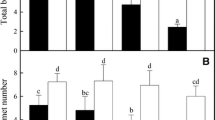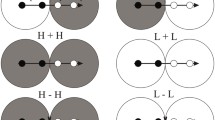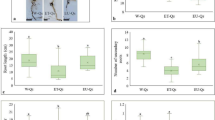Abstract
The invasive clonal plant Wedelia trilobata contains higher levels of ent-kaurane diterpenes, which are precursors of gibberellins (GAs), and higher rates of clonal growth than its native congener W. chinensis in invaded habitats. We hypothesized that the higher levels of endogenous GAs facilitate greater ramet growth in W. trilobata compared with W. chinensis. We quantified endogenous levels of GA1+3 in the two species and compared their growth responses to the changes of endogenous and exogenous GA3 by using short-term and long-term hydroponics experiments. After a period of homogeneous cultivation, levels of endogenous GA1+3 were higher in W. trilobata than in W. chinensis. The reduction of endogenous GAs repressed the emergence of adventitious roots and the growth of W. trilobata in the initial cultivation stage, and inhibited its shoot elongation and biomass. Levels of endogenous GA1+3 were positively correlated with the length of shoots and adventitious roots of W. trilobata. Adventitious roots of W. trilobata also emerged earlier and grew faster when treated with exogenous GA3. In contrast, exogenous GA3 treatment inhibited the length of adventitious roots in W. chinensis, and levels of endogenous GA1+3 did not correlate with shoot or adventitious root length. Our study suggests that GAs accelerate the rapid clonal growth of W. trilobata, more than that of its native congener W. chinensis, illustrating the relationship between plant hormones and the clonal growth of invasive plants. These findings are important for understanding the mechanisms associated with the invasiveness of clonal plants and their potential management.







Similar content being viewed by others
References
Blossey B, Notzold R (1995) Evolution of increased competitive ability in invasive nonindigenous plants: A hypothesis. J Ecol 83:887–889
Callaway RM, Aschehoug ET (2000) Invasive plants versus their new and old neighbors: A mechanism for exotic invasion. Science 290:521–523
Dayan J, Voronin N, Gong F, Sun TP, Hedden P, Fromm H, Aloni A (2012) Leaf-induced gibberellin signaling is essential for internode elongation, cambial activity, and fiber differentiation in tobacco stems. Plant Cell 24:66–79
DE Vleesschauwer D, VAN Buyten E, Satoh K, Balidion J, Mauleon R, Choi IR, Vera-Cruz C, Kikuchi S, Hofte M (2012) Brassinosteroids antagonize gibberellin- and salicylate-mediated root immunity in rice. Plant Physiol 158:1833–1846
Dech JP, Nosko P (2004) Rapid growth and early flowering in an invasive plant, purple loosestrife (Lythrum salicaria L.) during an El Niño spring. Int J Biometeorol 49:26–31
Dong BC, Zhang MX, Alpert P, Lei GC, Yu FH (2010) Effects of orientation on survival and growth of small fragments of the invasive, clonal plant Alternanthera philoxeroides. PLoS One 5:e13631
Dupuy L, Gregory PJ, Bengough AG (2010) Root growth models: towards a new generation of continuous approaches. J Exp Bot 61:2131–2143
Eppinga MB, Rietkerk M, Dekker SC, DE Ruiter PC, VAN DER Putten WH (2006) Accumulation of local pathogens: A new hypothesis to explain exotic plant invasions. Oikos 114:168–176
Eriksson ME, Israelsson M, Olsson O, Moritz T (2000) Increased gibberellin biosynthesis in transgenic trees promotes growth, biomass production and xylem fiber length. Nat Biotechnol 18:784–788
Fransen B, DE Kroon H (2001) Long-term disadvantages of selective root placement: root proliferation and shoot biomass of two perennial grass species in a 2-year experiment. J Ecol 89:711–722
Gahoonia TS, Nielsen NE (2004) Root traits as tools for creating phosphorus efficient crop varieties. Plant Soil 260:47–57
Gahoonia TS, Ali R, Malhotra RS, Jahoor A, Rahman MM (2007) Variation in root morphological and physiological traits and nutrient uptake of chickpea genotypes. J Plant Nutr 30:829–841
Gou JQ, Strauss SH, Tsai CJ, Fang K, Chen YR, Jiang XN, Busov VB (2010) Gibberellins regulate lateral root formation in Populus through interactions with auxin and other hormones. Plant Cell 22:623–639
He WM, Alpert P, Yu FH, Zhang LL, Dong M (2011) Reciprocal and coincident patchiness of multiple resources differentially affect benefits of clonal integration in two perennial plants. J Ecol 99:1202–1210
Hedden P, Graebe J (1985) Inhibition of gibberellin biosynthesis by paclobutrazol in cell-free homogenates of Cucurbita maxima endosperm and Malus pumila embryos. J Plant Growth Reg 4:111–122
Hedden P, Phillips AL (2000) Gibberellin metabolism: new insights revealed by the genes. Trends Plant Sci 5:523–530
Hoagland DR, Arnon DI (1950) The water-culture method for growing plants without soil. University Of California, Agriculture Experimental Station 347:1–32
Horst WJ, Kamh M, Jibrin JM, Chude VO (2001) Agronomic measures for increasing P availability to crops. Plant Soil 237:211–223
IUCN (2001) 100 of the world's worst invasive alien species. Invasive Species Specialist Group, Auckland. Available from http://www.issg.org/database/species/search.asp?st=100ss
Keane RM, Crawley MJ (2002) Exotic plant invasions and the enemy release hypothesis. Trends Ecol Evol 17:164–170
Keser LH, Dawson W, Song YB, Yu FH, Fischer M, Dong M, VAN Kleunen M (2014) Invasive clonal plant species have a greater root-foraging plasticity than non-invasive ones. Oecologia 174:1055–1064
Little CHA, MacDonald JE (2003) Effects of exogenous gibberellin and auxin on shoot elongation and vegetative bud development in seedlings of Pinus sylvestris and Picea glauca. Tree Physiol 23:73–83
Lo SF, Yang SY, Chen KT, Hsing YL, Zeevaart JAD, Chen LJ, Yu SM (2008) A novel class of gibberellin 2-oxidases control semidwarfism, tillering, and root development in rice. Plant Cell 20:2603–2618
MacArthur R (1970) Species packing and competitive equilibrium for many species. Theor Pop Biol 1:1–11
McNickle GG, St Clair CC, Cahill JF (2009) Focusing the metaphor: plant root foraging behaviour. Trends Ecol Evol 24:419–426
Mooney HA, Cleland EE (2001) The evolutionary impact of invasive species. Proc Natl Acad Sci U S A 98:5446–5451
Novoplansky A (2009) Picking battles wisely: plant behaviour under competition. Plant Cell Environ 32:726–741
Osmont KS, Sibout R, Hardtke CS (2007) Hidden branches: developments in root system architecture. Annu Rev Plant Biol 58:93–113
Qi SS, Dai ZC, Miao SL, Zhai DL, Si CC, Huang P, Wang RP, Du DL (2014a) Light limitation and litter of an invasive clonal plant, Wedelia trilobata, inhibit its seedling recruitment. Ann Bot-London 114:425–433
Qi SS, Dai ZC, Zhai DL, Chen SC, Si CC, Huang P, Wang RP, Zhong QX, Du DL (2014b) Curvilinear effects of invasive plants on plant diversity: plant community invaded by Sphagneticola trilobata. PLoS One 9:e113964
Qiang Y, Du DL, Chen YJ, Gao K (2011) ent-kaurane diterpenes and further constituents from Wedelia trilobata. Helv Chim Acta 94:817–823
Roiloa SR, Retuerto R (2012) Clonal integration in Fragaria vesca growing in metal-polluted soils: parents face penalties for establishing their offspring in unsuitable environments. Ecol Res 27:95–106
Santner A, Calderon-Villalobos LIA, Estelle M (2009) Plant hormones are versatile chemical regulators of plant growth. Nat Chem Biol 5:301–307
Shan DP, Huang JG, Yang YT, Guo YH, Wu CA, Yang GD, Gao Z, Zheng CC (2007) Cotton GhDREB1 increases plant tolerance to low temperature and is negatively regulated by gibberellic acid. New Phytol 176:70–81
Si CC, Dai ZC, Lin Y, Qi SS, Huang P, Miao SL, Du DL (2014) Local adaptation and phenotypic plasticity both occurred in Wedelia trilobata invasion across a tropical island. Biol Invasions 16:1–15
Sol D, Maspons J, Vall-Llosera M, Bartomeus I, Garcia-Pena GE, Pinol J, Freckleton RP (2012) Unraveling the life history of successful invaders. Science 337:580–583
Song LY, Chow WS, Sun LL, Li CH, Peng CL (2010) Acclimation of photosystem II to high temperature in two Wedelia species from different geographical origins: implications for biological invasions upon global warming. J Exp Bot 61:4087–4096
Steffens B, Wang JX, Sauter M (2006) Interactions between ethylene, gibberellin and abscisic acid regulate emergence and growth rate of adventitious roots in deepwater rice. Planta 223:604–612
Swain SM, Singh DP (2005) Tall tales from sly dwarves: novel functions of gibberellins in plant development. Trends Plant Sci 10: 123–129
Takahashi N, Kitamura H, Kawarada A (1955) Biochemical studies on 'Bakanae' fungus. XXXIV. Isolation of gibberellins and their properties. Bull Agr Chem Soc Japan 19: 267
Teng NJ, Wang J, Chen T, Wu XQ, Wang YH, Lin JX (2006) Elevated CO2 induces physiological, biochemical and structural changes in leaves of Arabidopsis thaliana. New Phytol 172:92–103
Thebaud C, Simberloff D (2001) Are plants really larger in their introduced ranges? Am Nat 157:231–236
Toh S, Imamura A, Watanabe A, Nakabayashi K, Okamoto M, Jikumaru Y, Hanada A, Aso Y, Ishiyama K, Tamura N, Iuchi S, Kobayashi M, Yamaguchi S, Kamiya Y, Nambara E, Kawakami N (2008) High temperature-induced abscisic acid biosynthesis and its role in the inhibition of gibberellin action in Arabidopsis seeds. Plant Physiol 146:1368–1385
Traw MB, Bergelson J (2003) Interactive effects of jasmonic acid, salicylic acid, and gibberellin on induction of trichomes in Arabidopsis. Plant Physiol 133:1367–1375
Tsutsumi D, Kosugi K, Mizuyama T (2003) Root-system development and water-extraction model considering hydrotropism. Soil Sci Soc Am J 67:387–401
Vila M, Espinar JL, Hejda M, Hulme PE, Jarosik V, Maron JL, Pergl J, Schaffner U, Sun Y, Pysek P (2011) Ecological impacts of invasive alien plants: A meta-analysis of their effects on species, communities and ecosystems. Ecol Lett 14:702–708
Wang ZW, VAN Kleunen M, During HJ, Werger MJA (2013) Root foraging increases performance of the clonal plant Potentilla reptans in heterogeneous nutrient environments. PLoS One 8:e58602
Weber E, Sun SG, Li B (2008) Invasive alien plants in China: diversity and ecological insights. Biol Invasions 10:1411–1429
Yang YM, Xu CN, Wang BM, Jia JZ (2001) Effects of plant growth regulators on secondary wall thickening of cotton fibres. Plant Growth Regul 35:233–237
Yang JC, Zhang JH, Liu K, Wang ZQ, Liu LJ (2006) Abscisic acid and ethylene interact in wheat grains in response to soil drying during grain filling. New Phytol 171:293–303
Yaxley JR, Ross JJ, Sherriff LJ, Reid JB (2001) Gibberellin biosynthesis mutations and root development in pea. Plant Physiol 125:627–633
Yu H, Liu JA, He WM, Miao SL, Dong M (2011) Cuscuta australis restrains three exotic invasive plants and benefits native species. Biol Invasions 13:747–756
Zhao J, Li G, Yi GX, Wang BM, Deng AX, Nan TG, Li ZH, Li QX (2006) Comparison between conventional indirect competitive enzyme-linked immunosorbent assay (icELISA) and simplified icELISA for small molecules. Anal Chim Acta 571:79–85
Zhu XF, Jiang T, Wang ZW, Lei GJ, Shi YZ, Li GX, Zheng SJ (2012) Gibberellic acid alleviates cadmium toxicity by reducing nitric oxide accumulation and expression of IRT1 in Arabidopsis thaliana. J Hazard Mater 239:302–307
Acknowledgments
This work was supported by the National Natural Science Foundation of China (31170386, 31570414, 31200316), the Natural Science Foundation of Jiangsu (BK20150503, BK20150504), the Jiangsu University Research Foundation (14JDG010, 15JDG032), the Natural Science Research Project of Higher Education of Jiangsu (14KJB610005), the Jiangsu Planned Projects for Postdoctoral Research Funds (1501028B), the Priority Academic Program Development of Jiangsu Higher Education Institutions (PAPD), the Jiangsu Collaborative Innovation Center of Technology and Material of Water Treatment. We thank Professor Fei-Hai Yu (Beijing Forestry University, China) and Professor Jun-Min Li (Taizhou University, China) who provided the ramets of W. chinensis. We also appreciate the editors and anonymous reviewers for their critical comments.
Author information
Authors and Affiliations
Corresponding author
Electronic Supplementary Material
Figure S1
(DOC 1550 kb)
Rights and permissions
About this article
Cite this article
Dai, ZC., Fu, W., Qi, SS. et al. Different Responses of an Invasive Clonal Plant Wedelia trilobata and its Native Congener to Gibberellin: Implications for Biological Invasion. J Chem Ecol 42, 85–94 (2016). https://doi.org/10.1007/s10886-016-0670-6
Received:
Revised:
Accepted:
Published:
Issue Date:
DOI: https://doi.org/10.1007/s10886-016-0670-6




